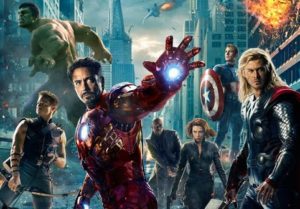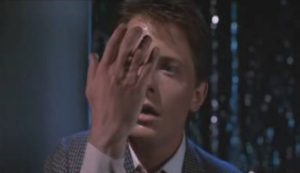Spoiler alert: this blog post contains significant spoilers about WALL-E, and contains minor spoilers about Salt (although these shouldn’t be spoilers to anybody who’s ever seen an
action film before).
The Bechdel Test
I’ve talked to some of you already about my thoughts on the Bechdel Test, which aims to illustrate the under-representation of women in contemporary film. I first became
aware of the test when I saw this video
by YouTube blogger “feministfrequency”, earlier this year. If you can’t be bothered to watch the video, here’s a summary:
Alison Bechdel is the author of a long-running comic strip, Dykes To Watch Out
For. In 1985, one of the characters in the strip states that she only watches a movie if it meets the following requirements:
- It has at least two women in it, (some later versions of the test require that the women be named characters)
- Who talk to teach other,
- About something besides a man.
feministfrequency goes on to show that the problem is endemic by flicking rapidly through a list of films that “fail” the test (she skips over the part of her argument where she
demonstrates that this is a problem, presumably because she feels that this is obvious and, besides, YouTube’s consumers will often have too short an attention span to take in a
proper argument anyway).

In the snapshot above, we can see her explaining how WALL-E fails the test.
Whoah, hang on a minute. WALL-E? Are we sure?
The Problem with The Bechdel Test
Let’s have a look at WALL-E. Here’s a summary of the plot, in case you’ve been in a coma for the last few years and the first thing you chose to do when you came around was to read my
blog:
- Runaway consumerism and lack of ecological foresight results in Earth being too polluted to live on.
- The humans all evacuate to space, leaving behind an army of trash compactor robots, “Waste Allocation Load Lifter – Earth class”.
- After centuries, only one of these survives, and has achieved sentience.
- A robotic probe sent down by the humans, an “Extraterrestrial Vegetation Evaluator” (EVE) probe and the surviving WALL-E unit form an emotional bond.
- The EVE is called back to the mothership with evidence that Earth is becoming livable again. The WALL-E comes aboard as a stowaway.
- Meanwhile, on the spaceship, the human captain (male) is in conflict with the ship’s computer, which hides evidence of Earth’s livability in order to keep the lazy, dis-focused
space-dwelling humans under its authority.
- Through a series of scrapes and adventures, the WALL-E unit and the EVE manage to survive the ship’s computer’s attempt to kill them and present the evidence that Earth is becoming
habitable to the humans, who land the ship.
- Finally, in a heartbreaking moment, the WALL-E appears to have been reset to its factory configuration, losing its intelligence and self-awareness, until an electrical spark passed
during a “kiss” from the EVE causes the WALL-E to jump-start back into being its usual, quirky, self.
So there’s WALL-E. Does it pass the Bechdel Test? No. Well, I guess I’m wrong, then.
But the problem is: I only feel that a failure to the Bechdel Test is in any way significant if the film would pass its male-centric analog. After all, we can all say that the
world is unfair because we haven’t personally passed the “Lottery Jackpot Test” – winning millions of pounds – but if only a handful of people ever do pass that test, then it’s
not fair to say that I personally am unlucky: I’m pretty much just as unlucky as everybody else.
I propose a male-centric analog to the Bechdel Test. To pass this test, a film must have at least two male characters (ideally named), who talk to one another about something
other than a woman. It may seem like I’m being facetious – after all, virtually all movies will pass this test – but I don’t feel that it’s appropriate to comment on the fact that a
movie fails the Bechdel Test unless it also passes the male analog, for the same reason that I don’t feel it’s fair to use the fact that any given person has failed the “Lottery Jackpot
Test” as evidence of anything in particular either.
So, here’s my Revised Bechdel Test. To pass this test, a movie must:
- It has at least two women in it,
- Who talk to teach other,
- About something besides a man.
- AND it can not fail the test unless it has at least two men in it who talk to one another about something besides a woman.

So does WALL-E fail the Revised Bechdel Test (i.e. fails the Bechdel Test, but passes the male analog): I don’t think it does, but it depends, perhaps, on how you choose to define
gender. Many audience members will choose to identify the protagonist WALL-E unit as male, for example, despite the fact that it is clearly a robot manufactured in a way that makes
gender irrelevant. They choose to do this because of their conditioning:
- Lead characters in films are frequently male, so – in the absence of any evidence to the contrary – an audience will associate masculinity to a genderless character presented to
them.
- WALL-E units are dirty, engaged in manual labour, and with “rugged” square corners; these are characteristics that audiences will readily assume to be masculine traits because of
the stereotypes within our society.
- The WALL-E unit engages in a romantic relationship with a robot that – for similar stereotype-based reasons – the audience will often designate as being female. Our culture of
heteronormativity means that when we discover that a character of a suspected gender forms a romantic relationship, that the subject of that relationship must be of the opposite gender.
Here are the options, then:
- We assume that all robots in the film are genderless. If this is the case, the film fails the Bechdel Test, but passes my Revised Bechdel Test. Note that the same would be true of
March Of The Penguins (this also fails the Bechdel Test, but I doubt
that any feminist could rightly claim that women are under-represented in it).
- We assume that all the robots in the film are of the same gender that their voice actor (please note that I don’t feel that this is a fair way to assign gender to characters: at
least six of the recurring male characters in The Simpsons are voiced by voice
actress Nancy Cartwright), with the exception of the ship’s computer, which
– voiced by a synthetic algorithm called MacInTalk
– remains genderless. In this case, the film still fails the Bechdel Test, and still passes my Revised Bechdel Test.
- We assign arbitrary genders to the robots in order to make our argument fit. Only in this case can we pass the Bechdel Test or can we fail my Revised Bechdel Test.
The Revised Bechdel Test I propose solves the greatest fundamental problem with the Bechdel Test: that it discriminates unfairly against films where gender is not an issue. In most
films involving nonhuman characters, the Bechdel test doesn’t provide sufficient granularity to tell the difference between “women being underrepresented” and “gender being irrelevant
to the story”. Note that “nonhuman characters” is still an ambiguous term, for there exist characters with sufficient anthropomorphism that they can be treated as human analogies, like
the stars of the original Toy Story, which fails both the Bechdel Test and my revised
test, and rightly so.
The Problem with The Revised Bechdel Test
I’m not claiming to have fixed the Bechdel Test completely, though, as a measure of the representation of women in films. Last night, I watched Salt.

I first became aware of this new film when I saw a trailer for it at the cinema when watching Inception (doesn’t pass either the Bechdel Test nor my Revised Bechdel Test, although this isn’t a measure of how good a film is,
and Inception is fantastic). Salt is a very typical modern action flick in many ways. Here are some of the common tropes of a modern action film, that Salt also has:
- The lead character is a secret agent, spy, assassin, detective, mercenary, or similar “cool” profession that entitles them to carry a gun.
- The lead character exhibits an almost-superhuman ability to withstand pain and torture, fight with a variety of weapons or barehand, learn multiple languages, pick locks, hack
computers, and so on.
- The organisation for which the lead character primarily works is of dubious trustworthiness.
- The lead character is betrayed by somebody once trusted to them, and is on at least one occasion described as “rogue”.
- A major motivation of the lead character is the liberation of their primary love interest.
- The whole movie is full of badass fight scenes and explosions.
You get it? I could be describing almost any James Bond
film, the Mission: Impossible series,
Minority Report, Robocop, the Bourne
film series; even The A-Team! But in this case, I’m describing Salt. And there’s one particular thing
that Salt does that none of these other films did: the lead character is a woman.
From a point of gender equality, this film does a really, really good job. It would be perfectly possible to change the gender of any of the major characters and still have
movie which remained perfectly intact. The lead character’s femininity is part of the plot, certainly, but not in a way that makes mockery of it or belittles her for her gender. Not
once does the lead female require the lead male to come and “rescue” her, or she is disadvantaged by her gender. Even the scene in which she disguises herself as a man is done not
because a man would have been required but because it was the most effective disguise that she could have used, at the time: one that completely changed her appearance.
But guess what: this fantastic (and undeniably-feminist) film… doesn’t pass the Bechdel Test. It doesn’t even pass my Revised Test! Why? Because despite the fact that it represents
women equally and counters the culture of male leads to action films (without making a point of doing so – gender is not a factor)… it doesn’t have a second named female
character for the lead female to talk to (about something other than a man). Men talk together during the film about something other than a woman (although not much – a lot of their
discussion is about the lead female, but they do on occasion talk about other things during the set-up), but it’s somehow a failure in the Bechdel Test simply because the film spends
most of the time, without dialogue, watching the protagonist be a awesome gun-toting badass.
The Bechdel Test is too coarse. My Revised Bechdel Test improves its biggest failure, but still fails to detect films like Salt as being a good representation of women in movies. And if
anybody’s got any suggestions about how we could refine the test any further, I’d love to hear them.


















